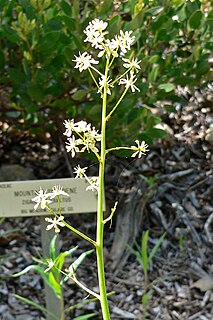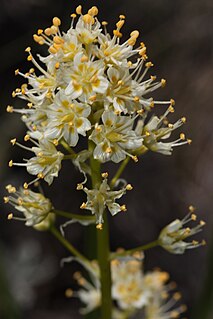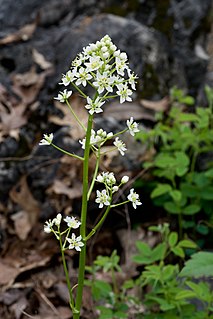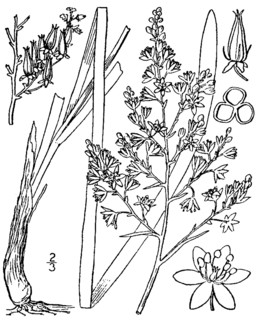
Melanthieae is a tribe of flowering plants within the family Melanthiaceae. Molecular phylogenetic studies in the 21st century have resulted in a large-scale reassignment of many of its species to different genera; in particular the genus Zigadenus (deathcamases) has been restricted to a single species, Zigadenus glaberrimus. Plants contain alkaloids, making them unpalatable to grazing animals; many are very poisonous to both animals and humans.

Toxicoscordion fremontii, known as the common star lily or Frémont's deathcamas or star zigadene, is an attractive wildflower found on grassy or woody slopes, or rocky outcrops, in many lower-lying regions of California, southwestern Oregon, and northern Baja California.

Toxicoscordion venenosum, with the common names death camas and meadow death camas, is a species of flowering plants in the genus Toxicoscordion, of the Melanthiaceae family. It is native to western North America.
Hog potato is a common name for several plants with edible or poisonous bulbs and tubers. Hog potato may refer to:
Star lily or starlily is a common name for several plants and may refer to:

Anticlea elegans, formerly Zigadenus elegans, is also known as mountain deathcamas, elegant camas or alkali grass. It is not a grass, but belongs to the trillium family, Melanthiaceae.

Toxicoscordion micranthum, the smallflower deathcamas, is a flowering plant in the genus Toxicoscordion. It is native to Oregon and California, primarily in the Coast Ranges from Douglas County to Napa and Sonoma Counties, with isolated populations in Lassen, Plumas, Santa Clara, and San Benito Counties. It is a member of the serpentine soils flora.

Toxicoscordion exaltatum the giant deathcamas, is a North American flowering plant in the genus Toxicoscordion, reputed to be deadly poisonous. It is native to California, Oregon, and Nevada, where it can be found in the Sierra Nevada foothills.

Anticlea is a genus of flowering plants in the family Melanthiaceae, tribe Melanthieae. Molecular phylogenetic studies in the 21st century have resulted in number of changes to placements within this tribe. Anticlea was long submerged into the genus Zigadenus; however its separate position has been confirmed. Some species were also moved from Stenanthium into Anticlea. Members of Anticlea may also be distinguished from other members of the former genus Zigadenus, the deathcamases, by the presence of narrow tepals with a single, conspicuous, bilobed gland. It also has a wider distribution, occurring in Asia and much of North and Central America, ranging south to Guatemala.

Toxicoscordion is a genus of flowering plants in the family Melanthiaceae, tribe Melanthieae, first described as a genus in 1903. The genus is mainly distributed in the midwestern United States and western North America, with some species in western Canada and northern Mexico.

Stenanthium is a North American genus of flowering plants in the tribe Melanthieae of the family Melanthiaceae.

Zigadenus is a genus of flowering plants now containing only one species, Zigadenus glaberrimus, the sandbog death camas, found in the southeastern United States from Mississippi to Virginia. Around 20 species were formerly included in the genus, but have now been moved to other genera.
Toxicoscordion brevibracteatum is a species of flowering plant known by the common name desert deathcamas. It is native to Baja California, Sonora, and California, where it grows in sandy desert habitat among creosote and Joshua trees.

Toxicoscordion paniculatum is a species of flowering plant known by the common names foothill deathcamas, panicled death-camas, and sand-corn. It is widely distributed across much of the western United States, especially in the mountains and deserts of the Great Basin region west of the Rocky Mountains. It grows in many types of habitat, including sagebrush plateau, grasslands, forests, and woodlands, etc.

Toxicoscordion nuttallii is a species of poisonous plant native to the south-central part of the United States.

Stenanthium leimanthoides is a poisonous monocot wildflower native to acid montane areas of the eastern United States. It is either treated as a separate species to Stenanthium densum or as a synonym of that species. A common name is pine barren deathcamas.
Toxicoscordion fontanum,, common name small-flower death camas, is a rare plant species known only from serpentine marshes in California. It is found primarily in the Coast Ranges from Mendocino County to San Luis Obispo County, with an additional report of an isolated population in the Sierra Nevada foothills in Kern County east of Bakersfield.

Zygacine is a steroidal alkaloid of the genera Toxicoscordion, Zigadenus, Stenanthium and Anticlea of the family Melanthiaceae. These plants are commonly known and generally referred to as death camas. Death camas is prevalent throughout North America and is frequently the source of poisoning for outdoorsmen and livestock due to its resemblance to other edible plants such as the wild onion. Despite this resemblance, the death camas plant lacks the distinct onion odor and is bitter to taste.
This page is based on this
Wikipedia article Text is available under the
CC BY-SA 4.0 license; additional terms may apply.
Images, videos and audio are available under their respective licenses.













